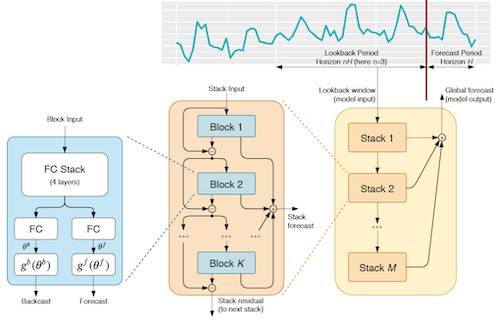This repo provides an implementation of the N-BEATS algorithm introduced in https://arxiv.org/abs/1905.10437 and enables reproducing the experimental results presented in the paper.
N-BEATS is a neural-network based model for univariate timeseries forecasting.
PyTorch implementation of N-BEATS can be found in models/nbeats.py
The loaders for each dataset used in the paper are in datasets/*.py
Experiments to reproduce the paper results are located in experiments/*,
where each experiment package contains main.py with the training and forecasting logic along
with two configuration files for both generic and interpretable models.
The notebooks directory contains a notebook per experiment with the final scores.
We also included the results for 10 times smaller ensembles,
you can see that the difference is not significant.
Note: This is a "lighter" version of original N-BEATS which performs slightly different,
sometimes better sometimes worse but overall on the same SOTA level.
Make sure you have docker installed. Using NVidia GPUs is preferable, but not required. Depending on your environment you may need to adjust Makefile's docker image name and write additional logic to train models in parallel.
The default configuration is using 10 repeats what produces up to 180 models per experiment, as you can
see in notebooks the difference between big and small ensembles is not significant.
To switch to small ensemble set build.repeats = 1 in *.gin files for experiments you want to run
(they are located in experiments/*/*.gin).
-
Build docker image
make init
-
Download datasets
make dataset
This command will download dataset into
./storage/datasetsdirectory -
(Optional) Test metrics. To make sure that all datasets are correct and the metrics calculation works as expected you can run test.
make test -
Build an experiment
make build config=experiments/m4/interpretable.gin
This will generate directories with configurations and command for each model of ensemble in
./storage/experiments/m4_interpretable. Note that theconfigparameter takes the relative path to actual configuration. -
Run experiments. Substitute different values for
repeatandlookbackin the command lines below to run other configurations of a model.CPU
make run command=storage/experiments/m4_interpretable/repeat=0,lookback=2,loss=MAPE/command
GPU
make run command=storage/experiments/m4_interpretable/repeat=0,lookback=2,loss=MAPE/command gpu=<gpu-id>
If you have multiple GPUs on the same machine then run this command in parallel for each gpu-id.
The logs, losses, snapshots and final forecasts will be stored in
storage/experiments/m4_interpretable/repeat=0,lookback=2,loss=MAPEdirectory.You can of course automate running across all experiments with the following example (assuming BASH):
for instance in `/bin/ls -d storage/experiments/m4_interpretable/*`; do echo $instance make run command=${instance}/command done
If you have resources where the training can be scaled in a "cloud", then consider adding a new target to the Makefile. Below is an example in pseudo-code:
run-all: rsync ${ROOT} ${network-share} for instance in $$(ls ${ROOT}/${experiment}); do \ cloud submit \ --image=${IMAGE} \ -v ${network-share}:/experiment \ -w /experiment \ -e PYTHONPATH=/experiment \ -e STORAGE=/experiment/storage \ -- \ bash -c "`cat ${ROOT}/${experiment}/$${instance}/command`"; \ done -
Get the experiment statistics.
Note: If the experiment was running in a cloud make sure the results are downloaded into
storage/experiments.Start JupyterLab
make notebook port=<port>Run a notebook in
notebooksdirectory for the corresponding experiment to get the experiment's performance statistics.
If you use N-BEATS in any context, please cite the following paper:
@inproceedings{
Oreshkin2020:N-BEATS,
title={{N-BEATS}: Neural basis expansion analysis for interpretable time series forecasting},
author={Boris N. Oreshkin and Dmitri Carpov and Nicolas Chapados and Yoshua Bengio},
booktitle={International Conference on Learning Representations},
year={2020},
url={https://openreview.net/forum?id=r1ecqn4YwB}
}
This is a collaborative work between Element AI and Mila. Please cite the paper if you use this model or the code.
